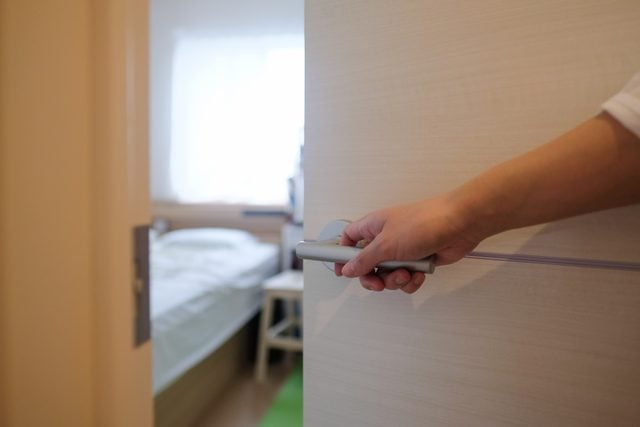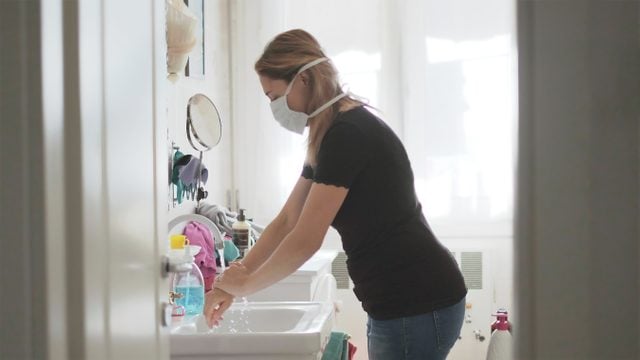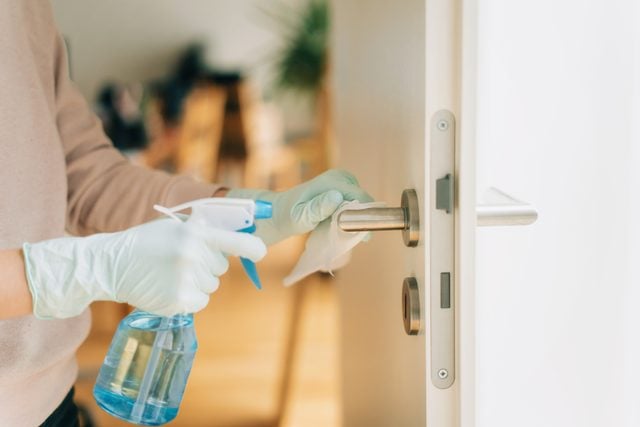How to Manage a Hot Zone in Your Home If Someone Has Covid-19
Updated: Apr. 11, 2020
Experts reveal how to reduce the spread of coronavirus if a family member has Covid-19 symptoms.
It’s one of the biggest fears for households around the world right now—a member of the family suddenly starts displaying coronavirus symptoms. The symptoms of the virus can include a fever, cough, and shortness of breath, as well as fatigue, aches and pains, and a sore throat, says the World Health Organization. (Less common symptoms are diarrhea, nausea, or a runny nose.)
If you or someone you live with has Covid-19 but isn’t sick enough to go to the hospital, there are best practices that should be followed at home to prevent and stop the spread of the virus. Here’s what you need to know about creating a safe space in your home for the sick patient while also protecting other members of the household.
Know the Covid-19 symptoms
Covid-19 can spread from person to person—mainly through respiratory droplets produced when an infected person coughs or sneezes. Therefore, it’s imperative that you take quick action to protect other members of your household. While it may only be a cold or the flu, now is no time to take chances.
“If someone has presumed or suspected Covid-19, they should be self-isolating,” says Georgine Nanos, MD, a board-certified family physician specializing in epidemiology in Encinitas, California. “Symptoms may appear similar to the flu, with congestion, headache, fatigue, muscle aches, cough, fever, and possible vomiting and diarrhea. If you have questions or concerns, you should consult your healthcare provider via a virtual medical or telehealth visit. The most worrisome symptom is shortness of breath or difficulty breathing.”

Designate an isolation room
At your healthcare provider’s recommendation, create an isolation room also known as a “hot zone” for the sick person. “People who are sick should not go anywhere they can spread the illness,” says Paul Krupin, a retired environmental scientist who trained as an EMT and wilderness first aid responder. “This means they must stay in one place in the house and avoid going into rooms that other people will use.”
How do you select the isolation room? Choose a comfortable room where the person can remain for the entire duration of their illness. “Ideally the room should have windows that could open to circulate air and provide natural sunlight, and a door that can shut as well,” says Dr. Nanos. “The door should stay closed at all times and ideally the room should have a bathroom attached or nearby.”
So what happens if the infected person doesn’t have access to a private bathroom? They should take extra precautions to use gloves and a face mask when using a common bathroom. Dr. Nanos says they must also close the toilet lid before flushing, because “we are learning the Covid-19 virus can be spread through fecal contamination.” The bathroom should be thoroughly disinfected by the caregiver after they leave. (If you’re caring for someone who’s sick, follow these 7 tips to avoid caregiver burnout.)
Choose one caregiver
Someone is going to need to step up and take care of the sick family member in the hot zone. Don’t draw straws. “Select the healthiest person in the house who is least likely get complications from Covid-19 if infected,” says Dr. Nanos. “This person will be in charge of food, medicine, comfort, reassurance, changing the linens, cleaning the room, and helping with bathing and personal hygiene if necessary.” If you’re not sure who to designate, consult this list of people who are at the highest risk from coronavirus and make sure they avoid the patient if at all possible .
It’s also the caregiver’s responsibility to monitor the person for worsening symptoms. The CDC says to seek immediate medical attention in the event of emergency warnings signs, such as trouble breathing, persistent pain or pressure in the chest, new confusion or inability to arouse, and blueish lips or face.
Nobody, except the caregiver, should enter the isolation room—and that includes pets. When you’re sick, kisses or snuggles with your dog or cat can be quite comforting, but refrain. While the CDC is only aware of a few cases where pets were infected with Covid-19 after close contact with people, it’s still wise to limit contact with pets and animals if you think you have coronavirus.

Wear masks and gloves
Now, it’s time to gear up properly to reduce the chances of virus transmission. “Have the sick person wear a face mask and disposable gloves when other people come into their room,” says Krupin. “Caregivers should wear a face mask and use latex gloves when entering the room of the sick person or coming close to them with food and medications.”
Masks and gloves must be treated as contaminated after use and disposed of properly (although homemade face masks can be washed and reused). Always wash your hands after touching contaminated masks and gloves, especially after coming out of the hot zone. Dr. Nanos also suggests wearing a hair covering and gown (or designated clothes) for that room only.
Disinfect the entire house
You have no way of knowing what the sick person touched prior to entering their isolation room, so it’s time for a deep clean. “Assume they have touched everything and disinfect all household surfaces thoroughly,” says Dr. Nanos.
Choose coronavirus-killing cleaning products and get to work on every table, chair, doorknob, light switch, telephone, electronic device (keyboards, mouse, tablets, cell phones, remote controls, etc.) cabinet handle, desk, countertop, toilet, sink, kitchen appliance, and anything else frequently touched in the home.
The CDC offers more tips on how to disinfect hard and soft surfaces. The agency recommends wearing disposable gloves while cleaning and disinfecting, and suggests following the instructions on the product labels to ensure safe and effective use.

Wash contaminated dishes, clothes, and linens
The caregiver will need to maintain a more vigilant level of cleanliness when it comes to handling anything in the sick person’s room and bringing it out into shared spaces. The CDC says to handle any used dishes, glasses, and silverware with gloves before washing with soap and hot water or in a dishwasher. The CDC also recommends leaving a dedicated, lined trash can in the isolation room and using gloves when disposing of trash.
When it comes time for laundering clothes, bedding and towels, use the warmest appropriate water setting and dry items completely. The good news is they don’t need to be washed separately from other household laundry, but do avoid shaking the dirty laundry, as it could spread germs. Don’t forget to disinfect the clothes hamper between loads. (Learn more about washing your clothes and protection against Covid-19.)
Remain vigilant about handwashing and face touching
Just as you’ve been hearing nonstop for weeks, washing your hands frequently remains incredibly important—and even more so with a sick person in the house.
“The single best defense for all of us is still frequent handwashing with regular soap and water,” says Dr. Nanos. “And if you don’t have access to soap and water, then use an alcohol-based hand sanitizer with greater than 60% alcohol.”
She also says to disinfect your phone at the same time that you disinfect your hands, and to avoid touching your face or putting your phone to your face if you have not had the opportunity to disinfect your hands or your phone.
“Remember, you can’t actually catch the virus through your hands,” she says. “It’s when your hands touch your eyes, nose, or mouth that you have the potential to become infected. We touch our faces at least 200 times per day without noticing.”
Stay in isolation for at least 72 hours after symptoms are gone
If your sick family member starts to feel better, that doesn’t mean you’re all out of the woods yet. “Isolation remains until he or she has gone 72 hours without any symptoms whatsoever,” says Dr. Nanos. “The medical community doesn’t have a lot of information about how long you are contagious after you’ve had the virus.” The CDC says the decision to stop home isolation should be made in consultation with your healthcare provider and state and local health departments.
Do you have a story to share about coronavirus? Click this link to share your Covid-19 story with us.
